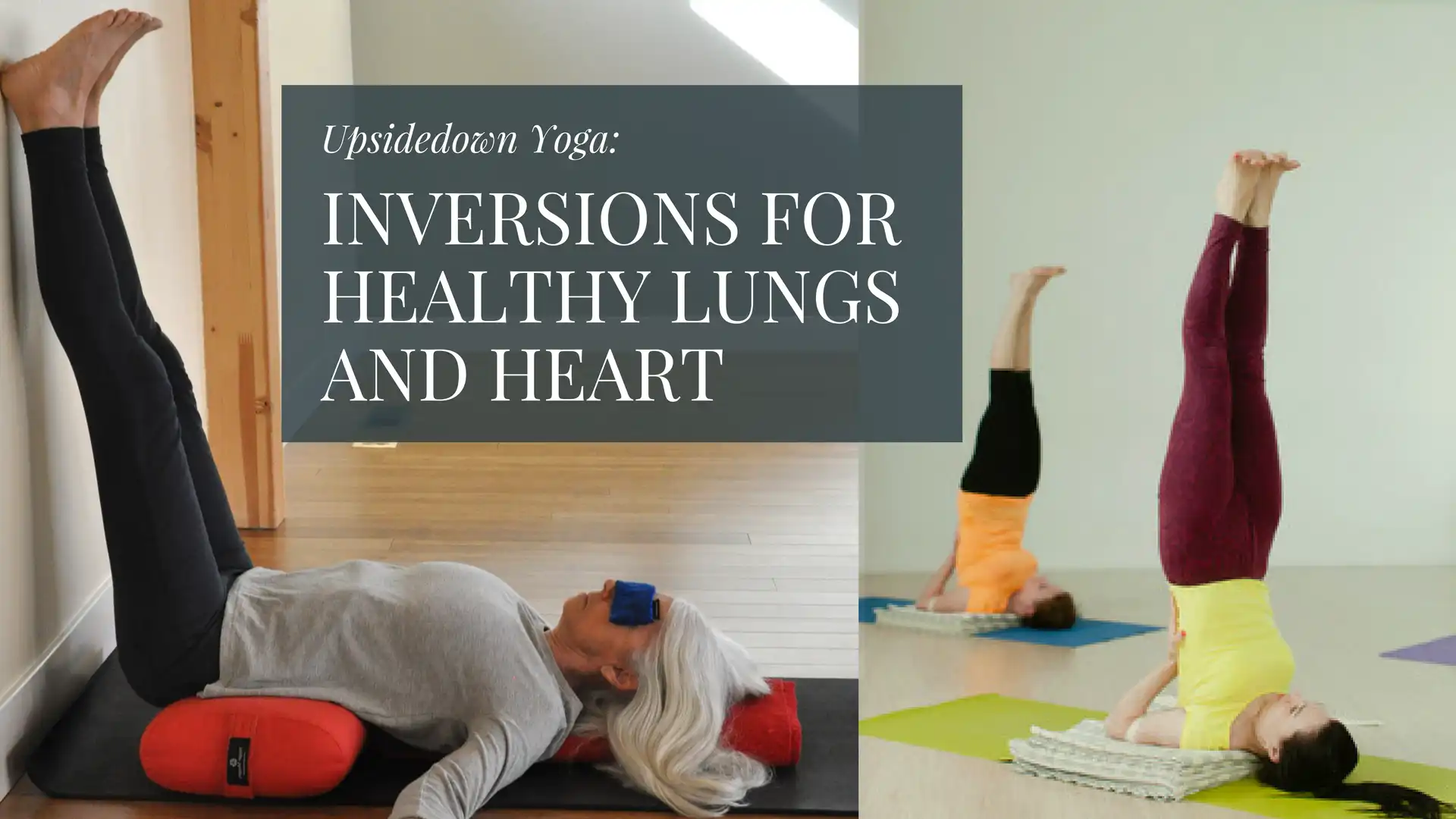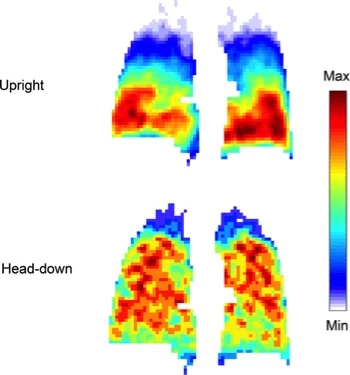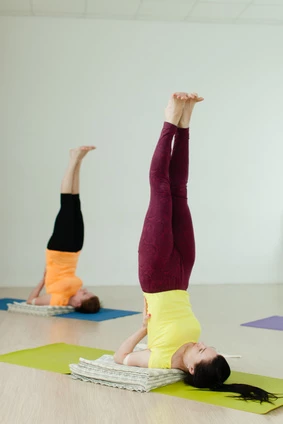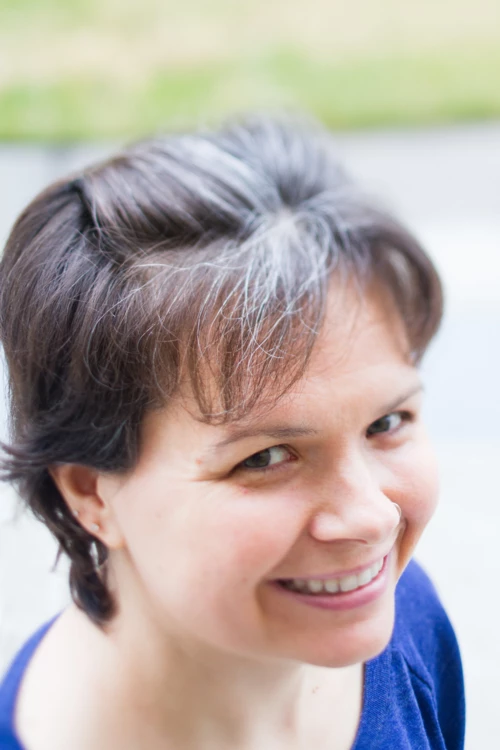Upside Down Yoga: Inversions for Healthy Lungs and Heart

When you are standing upright, you are subject to gravity. This is probably not a surprise. But what most people don’t think about is that the blood and organs in your body are also subject to gravity. Although our bodies are well designed to function with gravity, generally speaking, there are a few areas in which gravity can be a liability. For example, work is required to return blood and lymph (fluid similar to blood plasma carrying white blood cells) to your heart from your feet through your venous system. In fact, it turns out that gravity is one of the leading causes of venous disease. For this reason, turning upside down for short periods of time can be beneficial to the body. Below I’ll discuss those benefits, as well as some inversions from yoga that you might find helpful.
Blood Flow and Inversions
Your heart, which is situated in your chest cavity, is responsible for pumping oxygenated blood to different parts of your body through your arteries, and receiving de-oxygenated blood carrying waste product (carbon dioxide) through veins. Because the heart is so high up in the body when standing upright, there can be problems with the de-oxygenated blood traveling through veins returning to the heart against the force of gravity. When this system fails to work properly, there are several health consequences, both minor and major, including varicose veins, swollen feet and legs (edema), and risk of pulmonary embolism.
Effective prevention or treatment of venous diseases often includes positioning the feet higher than the heart to facilitate blood return to the heart. Tilt table therapy is effective for this, as studies have shown greater drainage of the calves and legs when the body is reclining with the head down. For healthy individuals, an inversion practice in yoga can also be an effective preventative measure.
The blood that saturates your lungs is also subject to the same effects of gravity. Blood is pumped from your heart into your lungs. In the alveoli of the lungs, oxygen from the air you breathe in is absorbed into your blood, and carbon dioxide from your blood is transferred to the air in your lungs. However, this exchange does not happen evenly across the surface of the lungs. When blood is pumped from the heart into the lungs, the blood first fills the bottoms of the lungs due to the effects of gravity.
On the whole, this is not a problem. The bottoms of our lungs are wide, and there is much surface area for gas exchange. But this means that the upper portions of the lungs do not see the same level or frequency of gas exchange that the lower lungs do. The image below shows the relative distribution of blood perfusion across the lungs in both an upright and a head-down position (image from Ax et al., 2017).

Going upside down can facilitate even perfusion of blood across the surface area of the lungs, rather than leaving some areas empty while other areas do all the work.
Diaphragm and Breathing

The diaphragm is a large muscle lying beneath the heart and lungs, separating the heart and lungs from the abdominal organs below. It is one of the most important muscles in the body because it is responsible for breathing. The diaphragm is a dome-shaped muscle with its apex (known as the central tendon) pointed upwards, lying just beneath the heart. When the diaphragm contracts, the central tendon draws down, and the entire muscle flattens out. This creates a vacuum in the lungs, which allows air to rush in. If the diaphragm is strong, it can allow more air into the lungs. If you sit in a chair most of the day, hunched over a computer, you are probably collapsing the front of your body, and the contractions of your diaphragm are likely to become weak, and your breathing is likely to become shallow.
The diaphragm is skeletal muscle, like most of the muscles in your body, and can gain strength in the same manner as other muscles. If you want to build your biceps, you grab a weight in your hand and start to flex your elbow. When you do this consistently over a long enough time period, your biceps will become stronger. Similarly, if you want to strengthen your diaphragm, you can do so by exercising it.
When the diaphragm contracts and pulls down, it is working with gravity. It pushes your abdominal contents down and forward, which is why your belly bulges when you breathe in. If you turn upside down, such as in Salamba Sirsasana (Headstand Pose), your diaphragm has to push up against the force of gravity, also pushing your heavy abdominal organs up and out of the way so air can rush into the lungs. Each breath you take when you are upside down requires more work of your diaphragm, just like lifting a weight requires more work of your biceps—breathing while upside down helps you to become a better breather when you are right side up.
Are Inversions Right for You?
Although there are many benefits to being upside down, there are also some risks and drawbacks, especially among people with certain pre-existing conditions. It’s unsafe for anyone to be upside down for extended periods (30-plus minutes). At this point, the benefits begin to give way to risks. People with high blood pressure, heart disease, glaucoma, detached retina, or any other condition that would affect circulation should avoid being upside down in most cases. As with any exercise regimen, always check with your doctor to see if it is right for you.
Recommended Inversions
Viparita Karani (Legs in the Air or Legs Up the Wall Pose)
Viparita Karani is an inversion that can be easily performed by most people, except for those with the contraindications listed in the paragraph above. You will need a mat and a folded blanket or yoga block for this pose.
- Set a yoga mat up so that it’s perpendicular to a wall.
- Place a folded blanket or block about four to six inches from the wall, with the widest side parallel to the wall. (Bolster shown in photo-right)
- If you are using a blanket, sit on one end of it and then swing your legs up the wall so that you end up with your pelvis resting on your blanket and your shoulders and head on the floor.
- If you are using a block, lie on the floor with your rear close to the wall, and your legs extended up the wall. Bend your knees and slide your feet down the wall. Then, lift your hips up and place your block under your pelvis so that the wide side of the block is four to six inches away from the wall. The block should be flat on the floor so that the widest face of it is under your pelvis.
- You can also practice these poses in the middle of the room with your legs up in the air instead of at a wall. But if you practice this against the wall, you can probably sustain it for a longer period of time.
- Maintain for 5-20 minutes.
Supported Salamba Sarvangasana (Shoulder Stand Pose) 
In a supported Shoulder Stand, you can use either a chair or the wall for support. You will need a yoga mat and at least two firm, folded blankets for this pose.
- To set up for the Shoulder Stand, stack at least two firm, folded blankets (each blanket should be folded to at least 18 inches by 22 inches or bigger and about 2 inches thick) under your upper back so that your shoulders are on the blankets and your head can rest on the floor so that your neck is not compressed. The wider dimension of the blanket should be parallel to the wall.
- If you are at the wall, begin lying on your back with your legs up the wall and your shoulders resting on the blanket, as described in Step 1. Bend your knees and place your feet on the wall. Push gently into your feet to raise your hips off the ground.
- Take a few breaths here to evaluate your breathing—are you able to breathe deeply? Are your neck and shoulders comfortable? If the answer to these questions is yes, you may proceed to the next step. If the answer is no, stay in this position with your feet on the wall.
- See if you can bring your hips over your shoulders with your hands supporting your lower back. If you feel balanced here, you can experiment with taking your feet off the wall.
- Stay for 1-3 minutes, depending on your level of comfort.
You can also practice this pose with your hips resting against the seat of a chair instead of the wall:
- Using a folding chair, position yourself with your upper back on a blanket stack (as in Step 1 above) and place your feet on the seat of the chair. Hold onto the legs of the chair and slowly lift your hips onto the edge of the seat.
- Keep your gaze looking up toward the ceiling and move your chin away from your chest.
- Stay for 1-3 minutes, depending on your level of comfort.
If you can balance in Salamba Sirsasana (Headstand Pose), this is another excellent inversion to practice. In Headstand, the strengthening effect of the diaphragm is greater than in Legs Up the Wall. If you are unfamiliar with this pose, it is recommended that you learn from a qualified teacher. Learning in person rather than by instructional video/book is highly recommended.
Also, explore the many health benefits of yoga & backbends – more yoga anatomy from Sara Doyle and YogaUOnline – Extend Your Spine: Backbending Yoga for Healthy Heart and Lungs.
Reprinted with permission from Sara Doyle Yoga Anatomy.
 Sara Doyle (Ph.D., E-RYT 500) has a Ph.D. in Anatomy and has taught anatomy to medical students, residents, and undergraduates at Duke University since 2003. She has a thorough understanding of the human body and the anatomy of movement. Sara has spent thousands of hours in the anatomy lab and participated in the dissection of hundreds of cadavers, giving her a unique perspective on how the body works and the anatomical variation between individuals. Her yoga classes and workshops reflect a science-based perspective and include the most current research available.
Sara Doyle (Ph.D., E-RYT 500) has a Ph.D. in Anatomy and has taught anatomy to medical students, residents, and undergraduates at Duke University since 2003. She has a thorough understanding of the human body and the anatomy of movement. Sara has spent thousands of hours in the anatomy lab and participated in the dissection of hundreds of cadavers, giving her a unique perspective on how the body works and the anatomical variation between individuals. Her yoga classes and workshops reflect a science-based perspective and include the most current research available.
Sara has completed two 200 hour trainings – the first with Sarah Trelease, and the second more recently with Srivatsa Ramaswami, a direct student of Krishnamacharya. She has also completed a 300-hour training. Currently, Sara is enrolled in the MBSR (mindfulness-based stress reduction) teaching program at the UMass Center for Mindfulness.
Further Reading:
Ax M, Sanchez-Crespo S, Lindahl GE, Mure M and Peterson J. 2017. The influence of gravity on regional lung blood flow in humans: SPECT in the upright and head-down posture. Journal of Applied Physiology 122(6) 1445-1451.
Lattimer CR and Mendoze E. 2016. Reappraisal of the utility of the tilt-table in the investigation of venous disease. European Journal of Endovascular Surgery (52) 854-861.
Schwewitz J, Roos R, van Aswegen H, Manda S. 2016. The effect of two passive head-down tilt positions on diaphragm excursion in healthy adults: A preliminary study. Physiotherapy Theory and Practice 32(3) 223-231




